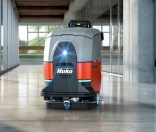Home › magazine › product features › Scrubber dryers be equipped for the future
Scrubber dryers - be equipped for the future
24th of April 2024The commercial cleaning industry is currently experiencing a phase of intense change. Driven by growing ecological and economic requirements as well as technological progress, companies are faced with the challenge of meeting new standards. Heading up this special report on scrubber dryers is Sabine Paul from manufacturer Hako, who tells us about the key factors influencing the development of new machines – including sustainability, labour force challenges, digitalisation, cost pressure, service and user preferences.
THE COMMERCIAL CLEANING industry is currently experiencing a phase of intense change. Driven by growing ecological and economic requirements as well as technological progress, companies are faced with the challenge of meeting new standards. In this dynamic phase, flexibility and adaptability are becoming key components for success - for manufacturers and service providers alike.
Sustainability, personnel development and digitalisation are topics that are currently relevant, but also point the way to the future of the industry.
How resources can be used more efficiently is one of the key issues in a sustainable world. Cleaning companies must find ways to make their services more environmentally friendly and provide evidence of this - while maintaining a consistently high level of cleaning quality.
The selection of highly efficient cleaning machines, whose performance is optimally matched to the area of application and which use environmentally friendly cleaning agents to save energy and water, is just as important as the implementation of sustainable business models.
The shortage of skilled workers is also becoming increasingly important. Attracting and retaining qualified staff has long since become a strategic challenge for cleaning service providers. Attractive working conditions, investment in training programmes and further training measures as well as the use of modern technologies and methods are decisive factors in the competition for talented employees.
Digitalisation, artificial intelligence and the Internet of Things are both a challenge and an opportunity. This is because they open up new possibilities for making cleaning processes more efficient and sustainable. Buildings are also becoming increasingly intelligent - the concept of smart buildings is playing an increasingly important role. The integration of intelligent systems, the networking of machines and the data-driven optimisation of processes are just some of the ways in which digitalisation is revolutionising the cleaning industry.
However, growing cost pressure and the unstable economic climate are also forcing companies to find innovative solutions to reduce water, chemical and energy consumption, work more efficiently and maintain the quality of their services at the same time.
A clean environment
Sustainability is now a fundamental prerequisite for long-term competitiveness and market acceptance - and is becoming a key challenge. The industry is responding: by turning to much more sustainable practices.
A key aspect of this is the reduction of resource consumption. By developing and promoting innovative technologies, cleaning processes can be made significantly more efficient. Modern cleaning systems use advanced techniques that minimise the need for aggressive chemicals without affecting the cleaning result. They ensure that only as much cleaning chemical is used as is actually needed - and with drip accuracy. This protects the environment and people’s health. In line with this is the increasing focus on biodegradable cleaning agents that achieve an effective cleaning performance without harmful residues.
The development of even more energy-efficient machines is also a step in the right direction. As they consume less energy, they are more environmentally friendly to use and therefore offer potential for long-term cost savings.
Promoting the circular economy is an essential part of manufacturing sustainable machines. Refurbishing allows machines to go through further life cycles. Recycled material reduces the impact on the environment. The high machine quality is maintained.
Overall, these trends reflect the industry’s growing awareness of its ecological responsibility and show ways in which commercial cleaning can be made even more environmentally friendly in the future.
Focus on user needs
When selecting cleaning machines, the needs and requirements of the user are also becoming increasingly important. User-friendliness is the top priority here. Cleaning machines should not only be powerful, but also easy and intuitive to operate. This saves valuable time when training new employees, reduces costly operating errors and increases productivity during use - also because the user can perform the required cleaning tasks quickly and flexibly with a machine that is optimally adapted to the area of application.
The ease of use of the machines is just as important. Ergonomically optimised, with user-friendly controls and intuitive handling, they make a significant contribution to occupational safety and increase the efficiency of cleaning processes. Low effort, high seating comfort and optimum adaptation to the individual physical needs of the user are further details that enable back-friendly and fatigue-free work during sometimes long cleaning operations.
Cost efficiency also remains a key issue: machines should not only be profitable to purchase, but also save costs during operation. Aspects such as energy efficiency, durability of materials and low maintenance costs are key. These factors are crucial for a sustainable, cost-efficient cleaning solution. Just like innovations that lead to shorter set-up and maintenance times.
For example, automatic filling systems, fast-charging batteries and technologies that minimise the consumption of water and cleaning agents can make a significant contribution to increasing efficiency. Such advances are essential to meet the needs of users and steer the industry towards a greener future.
The technological revolution
Technological developments in commercial cleaning are making huge strides - driven by digitalisation. A key element is the increasing integration of robotics into the cleaning process. Autonomous machines equipped with advanced sensors and navigation algorithms can clean
rooms independently. This reduces the manual workload, enables continuous, efficient cleaning and achieves very good results thanks to consistently high cleaning quality.
Another key advance is the combination of cleaning technology with artificial intelligence (AI). Machines equipped with AI can adapt to different environments and specific cleaning requirements, enabling a more precise and effective cleaning performance. In particular, the concept of predictive maintenance - the ability of machines to recognise and communicate their own maintenance needs. This approach reduces operating costs while increasing the availability and longevity of the machines.
In addition, intelligent fleet management systems enable optimised coordination and monitoring of cleaning machines. These systems provide real-time data on the operating status, operating times and performance of each machine, resulting in optimal scheduling and resource utilisation.
Overall, digitalisation and artificial intelligence in building cleaning not only lead to an increase in efficiency and productivity, but also to a higher quality of cleaning services.
Improving customer satisfaction with excellent service
The economic situation remains tense. Investments are being held back, company profits are shrinking and cost-cutting measures are the order of the day. In order to optimise the costs of commercial cleaning, companies must adapt their products and services even better to the needs and budgets of their customers.
In view of the economic challenges, it is also crucial to offer attractive procurement alternatives. Rental and leasing options are becoming increasingly attractive, as they can be flexibly adapted to the customer’s requirements.
The provision of short-term procurement alternatives is also becoming increasingly important. They enable cleaning service providers to quickly and easily adapt their machine usage to changing cleaning requirements - for example, through short-term rental contracts and modular service packages that enable rapid scaling and adaptation to different cleaning tasks.
Successfully shaping change: a look into the future
The commercial cleaning industry is constantly on the move. The direction it is taking due to changing conditions and technological developments is exciting - and challenging at the same time. But challenges become opportunities when they lead to improved utilisation as an impetus for innovation.
Companies that adapt to the changing market and changing requirements, integrate innovative and sustainable technologies and offer customer-oriented services will be able to strengthen or even further expand their market position. And master the balancing act between ecological success and economic responsibility by protecting the environment, remaining technologically up-to-date and financially profitable.










